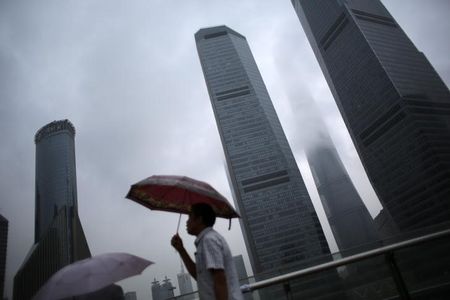By Xiaoyi Shao and Pete Sweeney
BEIJING (Reuters) - China's year-to-date foreign direct investment inflows declined for a third month in September, indicating investors remained cautious amid a further slowdown in the world's second-largest economy.
Investment for the month of September rose from a year earlier, however, after a sharp drop in August, though economists cautioned about reading too much into single-month data, which can be highly volatile.
In September, China attracted $9 billion (5.63 billion pounds) in FDI, up 1.9 percent from a year earlier, the Commerce Ministry said on Thursday. That compared with a 14 percent slide in August to $7.2 billion, a level not seen since February 2012.
That left China $87.4 billion of FDI in the first nine months of 2014, down 1.4 percent from a year earlier.
"Under the circumstances of no big fluctuations in the global and domestic situations, we expect China's FDI to keep its stable path this year," ministry spokesman Shen Danyang told reporters at a monthly media briefing.
FDI is an important gauge of the health of the external economy, to which China's vast factory sector is oriented, but it is a small contributor to overall capital flows compared with exports, which were worth about $2 trillion in 2013.
Shen said last month that China's FDI may hit an all-time high of $120 billion this year, barring no sharp changes in global capital flows
The investment data came as China's trade sector showed surprisingly strong performance in September, easing concerns about the risk of a sharper slowdown, though some economists suspected the export figures may have been inflated by speculative over-invoicing activities, as they were earlier in the year.
Shen said strong exports in September were normal but added the ministry would monitor flows to Hong Kong.
"We've noticed that exports of individual products from some regions to Hong Kong surged in September. We will enhance oversight with related departments," Shen said.
Beijing has struggled to prevent currency speculators from using simulated trade between Hong Kong and bonded customs zones using metals or lightweight items such integrated circuits to get more yuan on hand, circumventing controls on capital flows.
Such flows have been repeatedly blamed for producing mysterious spikes in exports even while trade with other Asian neighbours has fallen.
MORE FDI TO SERVICES
China's services sector attracted $48.6 billion of FDI in the first nine months of the year, up 8.7 percent from the same period last year, and faring much better than the manufacturing industry, where FDI dropped 16.5 percent to $29.6 billion.
The services sector appears to be holding up relatively well despite the cooling economy, while manufacturing has been weighed down by erratic exports, excess capacity in some sectors and a slumping property market, which is hurting demand for everything from glass and furniture to cement and steel.
Among the 10 countries that were the biggest sources of China's FDI, investment from South Korea surged 32.5 percent on an annual basis and that from Britain leapt 32.3 percent.
In contrast, investment from Japan plunged 43 percent from a year earlier while FDI from the United States and European Union dropped 24.7-18.8 percent, respectively.

China's non-financial direct outbound investment rose 21.6 percent in the first nine months from a year earlier to $75 billion.
(Editing by Jacqueline Wong & Kim Coghill)
